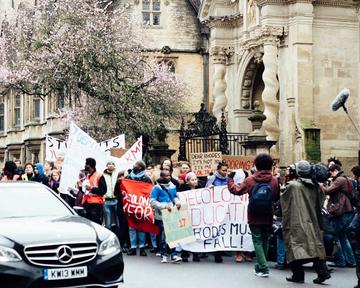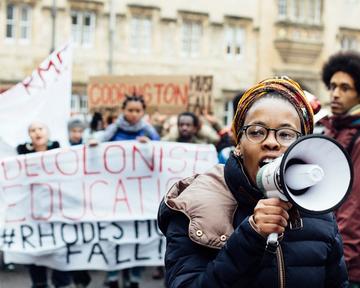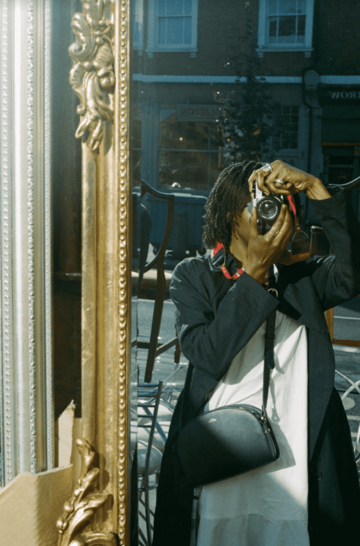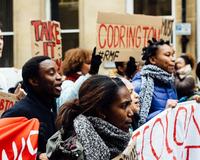Jacqueline Otagburuagu, Our Patient Documentarian
Photography as participatory politics: feminist anti-racism in Rhodes Must Fall
I.
Jacqueline Otagburuagu was not about conversions, religious or otherwise. When she saw Rose Chantiluke at the induction meeting for her master’s program at the University of Oxford in 2015, she noticed Rose’s crucifix earrings and her eyebrows, which were thick, arched, pure perfection. Jacquie wasn’t there to make friends, to find community, nor to seek fellowship, but Rose moved her. “She didn't invite me to a church service,” Jacquie says with some relief, “but she did invite me to Rhodes Must Fall.”
One night, Jacquie found herself following Rose to a meeting. “Oxford is so Oxford you know. It takes a long time before the place looks familiar,” Jacquie tells me. This is how she came to lean on Rose for direction. The girls walked on cobblestoned streets and turned into narrow corridors. It was 4 pm but it felt like the dead of night. The enclosed architecture, the high walls, shielded the streetlamps and made the darkened landscape less penetrable with the human eye or a camera’s flash. Entering a building on the campus of Corpus Christi College, they found some light.
“We open the door, and it’s this old room with all these different faces. And everyone is really talking quite passionately about this statue thing,” she remembered. It was also at this fateful meeting that I met Jacquie.
Jacquie knew of the Rhodes Must Fall Movement in South Africa, one that was Black and radical. The student uprising was not only a call to remove colonial statues from universities, it was also a struggle to make the movement’s ideological pillars of Pan-Africanism, Black Feminism, and Black Consciousness foundational education. When the door to the meeting opened, the non-Black faces shocked Jacquie. White men. Many women of colour—“the beige brigade.” African elites debating their fancy scholarships, a struggle she couldn’t understand when she had to work part time at the clothing store NEXT to pay for her degree.
She saw people whose demands would be covered by The Guardian. She saw students who wanted to be activists. That wasn’t her. Jacquie had grown up in South London and attended a “normal” university with a larger number of Black students for her bachelor’s degree. She had never felt like a minority, and she was too old for that experience now. Refusing to be swept away by laments of what it meant to be young, lonely, and Black, she made an internal promise not to take an active role in the movement. She took a seat at the edge of a long and crowded table, one elbow resting on the wood, the other on her knee, a quiet sigh.
Rose watched Jacquie at the meeting too. After a few weeks of friendship, she asked Jacquie if she would be willing to photograph the movement.
II.
It is because of love that Jacquie began taking pictures. To be loved and to be taken for granted, two concepts that can be harmonious or forced apart, two worlds that can make anyone disappear.
Jacquie’s love of photography began when she inherited a bag of photos that documented her mother’s arrival from Nigeria to the UK in the 1980s. “My mom gave me that bag because they were of her old life, including my father. So, she just gave all the family albums that she had to me.” By then Jacquie was estranged from her father, who had moved to the United States when she was a child. “I used to regularly tip the bag. The photos came out randomly. And I couldn’t really ask my mom and say, ‘hey look at this, the former love of your life.’” The separation made her reckon with her identity. Who was that man?
“There was just something about being able to trace the story and fill in the gaps. I would take the photos out, rearrange them, and try to put them in a timeline of when I thought they happened.”
Perhaps her interest in timelines was inspired by her growing affinity for history, familial and global. In her formal education, she cultivated a love for French which she would also study at university, but in her personal life she grappled with the visual aesthetics of marking truth, time, and place, “I got really into history in my teens because I was curious about myself. Why am I here? Why do we hate Black people? So, it just led me into all these paths and all these questions.”
Photography has not been the kindest medium for Black people to explore their histories, but it became Jacquie’s loving eye, one that didn’t look at people but asked questions with them. Sixteen-year-old Jacquie started documenting her life by photographing her birthday party, then another birthday party, then strangers at Notting Hill carnival who agreed to have their pictures taken. By the time she arrived at Oxford, she was twenty-five.
Her concerns about history were shared by students in Rhodes Must Fall Oxford. In all corners of that Corpus Christi room, people wrestled with the intimate intrusions of colonial and national histories. The Southern African side of the table, where I sat trying to make eye contact with the Black British girls, was filled with people confronting family histories that had been created or broken apart by Rhodes and his companies. Rhodes, who studied and donated money to Oxford, had not only made his fortune through gold and diamond mining in South Africa. His British South Africa Company stole land from Africans in countries that would be re-named Rhodesia (now Zimbabwe and Zambia), a territory where Black workers toiled under dehumanizing conditions, and economic exploitation gave way to apartheid policies. In that meeting room, students cast their complaints onto his statue, returning to that history so they could frame their daily struggles not as individual incidents of racism but as collective testament.

March to Decolonize Oxford (2016), images by Jacqueline Otagburuagu.
III.
Whenever Jacquie arrived at Rhodes Must Fall protests, she was surprised to see so many photojournalists there, all of them white men. She took pictures of them. By the time she photographed the second protest, a march around Oxford that took place on March 3rd, 2016, she had accepted that her photos wouldn't look like the ones showing up in newspapers. Unlike the men holding mics over people’s heads, she had proximity that came from being with the students, so close to them they didn't ask her to step away.
She watched strangers carrying signs that were painted by students, organisers cursing each other under their breaths, girls who didn't untwist their bantu knots when they needed to handle a confrontation. Her photos depicted the usual gestures of a protest, but they also had a fragile radiance, as if taken by a passerby. Always, she never forgot the trees, whether in bloom or in their skeletal form. They were a reminder that there is a season for everything—a time to plant and a time to uproot.
“I was drawn to the beauty of a lot of people,” Jacquie says remembering the protests, “It’s not like I took pictures of people I thought were beautiful. The passion was the beautiful thing.”
Eventually, signs were thrown away and pamphlets stashed into winter coats, signaling the end of the protest. Jacquie would go home and select photos for the movement’s Facebook group then give the rest of the images to the organisers. She then deleted the images from her computer. When I asked a former organiser to send me the folders of Jacquie’s photos, I found a whole history there of familiar and unfamiliar faces. There was a younger version of myself holding a blue umbrella I once loved but had forgotten I owned. There was Rose in an 80s style multi-colored sweater. And Anu, who fed us. And Nomfundo, who sometimes wouldn’t come out of her room but came out that day.
Then there was Naseemah Mohamed, a Rhodes scholar from Bulawayo, who in the serenity of childhood had played near Rhodes’ grave in Matopos Hills. As a Zimbabwean with mixed-race heritage, she was curious about how the European side of her family arrived in Bulawayo and took a DNA test. She learned that Rhodes himself had sent her great-grandmother, Catherine Le Roux, from Cape Town to Zimbabwe to take care of his lawyer’s children. It was there that Le Roux met Naseemah’s great-grandfather, a Black stonemason, and so the family story goes on and on for decades until we have an image of Naseemah holding onto a banner wrestling with how Rhodes’ legacy became so personal.
“One of my favourite pictures is the one with the Black guy. What’s his name? He’s gone really vegan now,” Jacquie says laughing. “I don’t remember his name, but he was standing in front of the protesters with his fist up and I was just like well obviously this is a brilliant photo.” Jacquie’s trying hard to remember the images she left behind for the movement, and it’s becoming clearer somehow. It’s her inherited way of engaging history, her own testament, you pass photos on so you can live. And if the memories are yours, they will come back to you.

March to Decolonize Oxford (2016), images by Jacqueline Otagburuagu.
IV.
Jacquie’s love of photography stopped her from asking for citation when her images were first uploaded onto the movement's social media and website without crediting her. She found joy in taking photographs of her friends, and many of the activists were friends or acquaintances. She had never thought of her photographs as something to be attributed to her or monetized, but something wasn’t right. As her last offering to the movement, she made sure her photos honoured Black women in the march, sometimes making them the main event more than the statue. “I had studied enough history to know,” Jacquie said, “that ‘women’ are often written out of movements.”
In the visual era of social media, a time of digital transnational movements, would women really be written out of history? Wasn’t the outside world interested in seeing rather than simply reading about Rhodes Must Fall Oxford? Wouldn’t there also be enthusiasm for this visual narrative to be told by Black women photographers?
I hoped too soon. I asked Athinangamso Nkopo, a co-editor of the movement’s anthology, Rhodes Must Fall: The Struggle to Decolonise the Racist Heart of Empire, why the 382-page book had no photos. She explained that there was a stack of images, most of them by Jacquie, that the co-editors had presented to Zedd Books, but the publishers refused to print photographs. It was too costly, and the book would be more accessible to a wider audience at a cheaper price. I understood that publishers must prioritise economic considerations over narrative, a choice that is not always unethical, but that decision had left urgent questions unanswered. What happened to the story of Rhodes Must Fall Oxford without a visual narrative? What is lost when Jacquie’s photos are scattered on social media without credit? How do we return to that place, to a movement’s pictorial attitude?

Jacqueline Otagburuagu self-portrait
V.
Jacquie stopped going to meetings before she left Oxford. The movement was already divided internally by racial and gendered lines. Jacquie had better things to do, other contributions to make. After graduating from university in 2016, she briefly worked as an assistant producer for the BBC. One afternoon, an email appeared proposing a documentary featuring a former Oxford student. The documentary was part of a film series that launched the public careers of up-and-coming scholars. Jacquie recognized the student’s name. He had been accused by multiple women of sexual assault, but he was still giving speeches at Rhodes Must Fall Oxford protest.
She screeeeeeeeeamed. No no no no no no no no no no.
Her BBC colleagues watched anxiously from their desks as the only Black person on the team yelled at her computer. She took her rage to Twitter where she could ask if anyone in that wide, wide world knew Black women academics who wanted to be in a documentary. “I forgot to make the tweet location specific,” Jacquie says, laughing. “So now it got to American Twitter and the American girls with all their PhDs are messaging me, telling me about their really niche thesis on like sex robots. Honey, I said, how am I gonna put this on TV?”
Waking up to thousands more messages, she deleted the tweet. “That was a Friday. I went out with the girls. I woke up hungover and my tweet had gone viral.”
Jacquie wasn’t trying to become the story, or go viral, even if it gave her great joy to see her inbox reflecting a reality that Rhodes and his legacy of white supremacy had tried to destroy. The world was a place with women ready to say something about life, and Jacquie could not be convinced otherwise. That is why so many of us had leaned on Jacquie all these years. She believed in what she saw through her viewfinder, on what she had considered through her own careful observation and years of documentation - those Black women were the majority.
Photography as participatory politics: feminist anti-racism in Rhodes Must Fall



